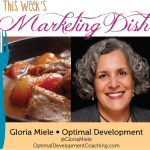Elizabeth Todd, the brains behind Income Trigger Consulting emailed this week’s suggestion. Here’s what she had to say about this particular dish:
When I first arrived in Australia I was invited to have Christmas with relatives of my girlfriend and there I discovered that a traditional English style Christmas lunch was served regardless of the temperature. Imagine a hot kitchen where turkey, ham, vegetables, etc have been roasted during the morning while the outside temperature has slowly been creeping up to 35o C (or, 95o F) or more. The meal is served around midday and a large plate of this hot food is followed by a generous serving of hot English plum pudding with warm custard. The first Christmas in my own home I was hosting the Christmas dinner and to my delight discovered this Ice Cream Christmas pudding. So instead of the traditional hot English Christmas lunch I served a buffet of cold ham and turkey and followed it with my newly discovered ice cream pudding. The meal was served around midday by the swimming pool and I’ve had many guests who were quite happy with the change in tradition and have been coming back for more ever since.
Elizabeth helps her small biz clients incorporate social media into their online marketing strategies. Connect with her on Twitter: @IncomeTrigger.
This week’s Marketing Dish is about Environments
I’ve never had the pleasure of eating Christmas pudding — ice cream or otherwise — but I totally get the desire to eat light on a warm day.
The Aussies (and other southern hemisphere folks) are deep into summer during the Christmas season. For them, it’s not about snow or fires in the fireplace. It’s about days at the beach, wearing shorts and soaking up the sun. (We have a lot of that in California, too.) The environment for them dictates how they want to experience the holiday season.
Guess what? It’s the same thing for your customers, audience members and prospects. Depending on the various environments they live in — real and virtual — you’ll want to adapt your message and how it’s delivered to suit their situations. That means, if they hang out on Twitter more than Facebook, you’ll need to spend more time there, too. You’ll also need to learn the culture and language of Twitter and how to pack a punch into 140 characters.
But there are other (real-life) environments we often overlook when crafting marketing messages. Your customers have lives that involve a host of variables like family, work and geography. Those variables dictate how and where they’ll be able to see, hear or consume your messages.
Have you taken those into account? Do they only have time to get online late at night? Are they living in urban areas? Or out in the country? And what’s going on in their lives right now?
Let’s say you sell items for dog owners. And you know that most of the folks who buy your products are women over 40. When you really look at who’s buying, you see that your ideal customer is a woman in mid-life. But you don’t necessarily know why. Consider her environment. She may be experiencing any number of these things:
- Empty-nest syndrome
- Divorce
- Hormonal changes
- Career changes
- Mid-life crisis
Or, she could be experiencing none of these. But you won’t know until you ask.
The point is, that understanding her environment — mental and physical — will help you create better marketing messages and connect with her on an emotional level (where she makes her purchasing decisions).
Perhaps (and this is just a guess), the changes in these women’s lives have left them feeling a bit lonely and they’re correcting that by adopting a pet. To them, these animals are more than just pets. They’re relationships. And you could use some of that language in your messaging to make a connection with them.
What about you? Do you know the various environmental factors affecting your ideal customer? Are you using that knowledge to connect with them on a deeper level? If you’re stumped for how to start and you’d like some help brainstorming, leave us a comment below and let’s see what we can do — together.











Madame The Chef has turned this cold Christmas lunch story into a perfect analogy and as I sit nodding my head I realise how important it is to fit the message to the reader. We only hear when we are ready and when the writing resonates with our situation we respond by listening.
This piece really reinforces the need to hone in on your ideal customer. I know many small business people want to believe that “everyone” is their customer, but, of course, that really isn’t true. I like the idea Elizabeth shared of following up on “NO” answers as well – that could be incredibly informational–if I can figure out how best to do that.
A great article Tea. I agree, getting to know what your ideal client needs and adapting to his/her changing needs is indeed important. A lot of business people however do have a problem trying to figure out how to go about it. One tip that may help here is to hone in on the NO answers. It’s a topic that was discussed at a network meeting that I attended last night and it really resonated with me. Follow up on a “NO” answer with a “WHY” question and you’ll fairly quickly learn a lot more about your client’s needs.